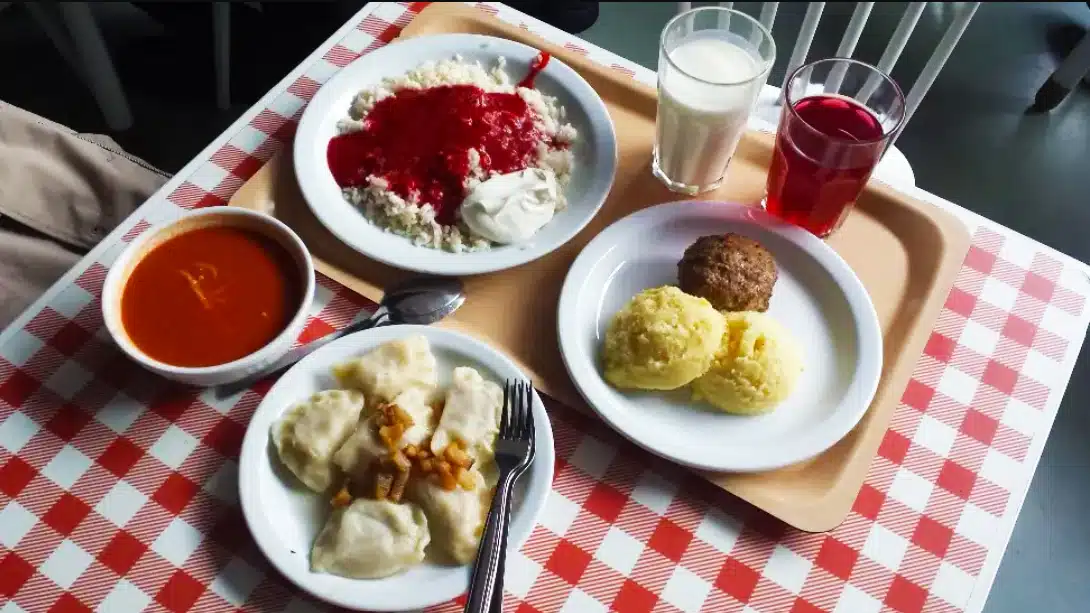This is a quick introduction to Warsaw’s milk bars, which are important cultural institutions as well as great places to eat, and to the Polish food they offer and the Polish language needed to order in them. While English-speaking eating establishments can be found, they will typically be more expensive and less of an important local experience than a milk bar, which typically do not speak English but which are a great value and popular with locals. These are highly recommended experiences for students on SRAS programs in Poland – and just about everyone else!
Introduction to Milk Bars
Although its name might be somewhat misleading, you shouldn’t expect to be able to order alcoholic drinks in a Polish “milk bar” or “bar mleczny.” In fact, a “milk bar” (at least in Poland) is actually a low priced cafeteria selling traditional dairy-based Polish food. Today, milk bars in Poland can vary greatly in price and quality/cleanliness, yet these two standards are in fact often not inversely related – meaning that there are great, modern, clean milk bars serving top quality Polish cuisine for moderate or even extremely low prices as well as grimy milk bars, serving plain tasting food at an average (or relatively high) price. Thus you can never really know what to expect exactly when you visit a new milk bar, but the hunt for one’s favorite milk bar (or the one that fits one’s taste best) can be a great way to explore new neighborhoods and fill your belly on a student’s budget.
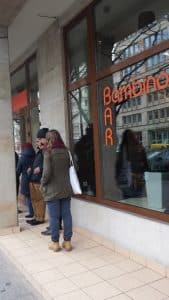
The Polish milk bar finds its origins in the early postwar era as a centralized solution by the Communist authorities to feed the masses of workers. The Communist Party’s concept was simple: to provide cheap, dairy-based meals to the masses, even including visits to the local milk bar in a worker’s salary. Yet poverty was so acute at the time that many milk bars chained the cutlery to the table to deter rampant thievery. It is for much the same reason that even today many milk bars use disposable dishes and dispense salt and pepper from behind the counter.
Aside from being tasty and cheap, milk bars also offer some degree of insight into the daily life of Poles under Communism. One of the relatively few leftovers of Poland’s communist era that has survived the country’s difficult transition to a market-based economy and remained quite popular, milk bars are also interesting for their cultural value. Although many died off during the transition to capitalism, those that remained were forced to evolve to maintain demand and generate profit after the loss of a full state subsidy. The great variety of milk bars then is in itself an interesting expression of the degree that each particular milk bar was forced to modernize or evolve in order to maintain the demand of the local consumers in that particular neighborhood or region. Today, there are even a number of post-communist reinventions of the milk bar that cater to tourists and those Poles looking for delicious Polish food in a more comfortable setting. Culturally and anthropologically, milk bars are a fascinatingly unique aspect of Polish culture that every visitor to Poland should experience.

Visiting a milk bar can, however, be quite the daunting challenge for a foreigner unacquainted with the process. Especially if you just landed, you may feel a bit of a culture shock with all signs and all communication only in Polish. The hardworking cooks bark out orders in Polish and can at times be unsympathetic to a confused foreigner holding up the line of hungry patrons. Especially if you don’t know your Polish cuisine, you may feel like you have no chance and just want to give up. For all of those reasons, I’ve put together this step-by-step guide to acquaint you with the process, ease your inhibitions, and open the door to enjoying an authentic Polish dining experience.
If you are interested in learning more about Polish history, see these articles from our sister site, GeoHistory.
What You’ll Find in a Milk Bar
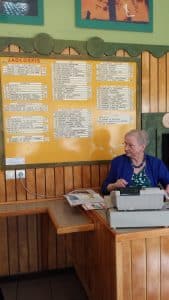
When you enter a milk bar around lunch time, you can expect a relatively long line, potentially out the door, depending on the milk bar’s location and its popularity. There will only be one large menu on the wall and it might be handwritten on a chalkboard. The menu is almost always (unless the milk bar caters to tourists) only in Polish and the workers will almost certainly not speak anything but Polish. So if it’s your first time to visit a milk bar or if you have no idea what you want, I suggest you stand to the side and decide what you want before you get in line. Don’t panic – once you know what you want, practice saying it or write it down on a piece of paper just to be safe. When you’re ready, get in line and wait to approach the cashier and order.
There are of course, differences between what each milk bar serves but most of the menu is actually almost the same across all milk bars. So once you know what the classics of Polish cuisine are, you can be fairly certain you can order these dishes at almost any milk bar, as long as they haven’t run out yet. Here is a list of some of the most common Polish dishes served in milk bars (and grouped into the same headings that are often found on milk bar menus):
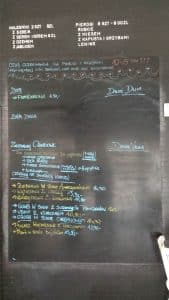
Dania Mączne (flour dishes)
Pierogi z mięsem – Polish dumplings filled with meat
Pierogi z kapustą – Polish dumplings filled with sauerkraut and (usually) mushrooms
Pierogi ruskie – literally “Russian” pierogi, these are actually the most classic Polish dumplings. They are filled with mixture of potato and farmer’s cheese.
Pierogi z owocami – Polish dumplings filled with fruit. These are sweet and dusted with powdered sugar and (potentially) cinnamon. The two most popular are:
Pierogi z jagodami – Polish dumplings filled with blueberries. A classic.
Pierogi z truskawkami – Polish dumplings filled with strawberries.
Pierogi leniwe – literally “lazy pierogi” these dumplings have no filling and are usually in the shape of a rectangle. They are made of flour and farmer’s cheese and topped with sugar and cream.
Naleśniki z serem – a Polish take on crepes that are filled with farmer’s cheese and topped with sugar and cream.
Naleśniki z jabłkami – Polish crepes filled with apples and topped with sweet cream and sugar.
Naleśniki z wiśniami – Polish crepes filled with cherries and topped with cream and sugar.
Zupy (Soups)
Żurek z jajkiem i kielbasą – Polish sour rye soup, filled with meat, potatoes, and boiled eggs
Barszcz czerwone z uszkami – red beet soup with small, mushroom-filled dumplings
Pomidorowa z makaronem/ryżem – tomato soup with either noodles or rice
Rosół z makaronem – chicken noodle soup
Pieczarkowa – mushroom soup
Flaki wołowe – beef tripe soup (made from intestines), an acquired taste
Kapuśniak – soup made of sauerkraut with potato, carrot, and often sausage
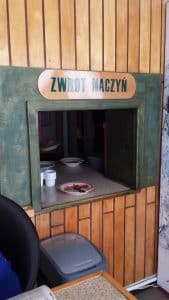
Danie mięsne (meat dishes)
Kotlet schabowy – breaded pork cutlet, similar to Wiener Schnitzel
Kotlet mielony – ground pork cutlet (breaded)
Udka (kurczak smażony) – fried chicken legs and thighs
Zrazy – beef roulades stuffed with pickles and bacon
Gołąbki w sosie pomidorowym – literally “pigeons in tomato sauce,” these are actually meat and rice wrapped in boiled cabbage leaves
Bigos – stewed cabbage with carrots, onions, and meat
Dodatki (sides/extras)
Ziemniaki – potatoes
Kapusta – sauerkraut
Surówka – small salad of mixed vegetables, usually pickled, sometimes served with a sauce
Bułka – bread roll
Napoje – (drinks)
Kompot – homemade fruit juice, often with pieces of fruit at the bottom
Herbata – tea
Kefir – cultured, yogurty milk drink
Kawa – coffee

Ordering Basics (A Language Lesson)
All that you really need to be able to say in order to communicate your order is actually quite simple. Basically you will say “please” followed by a number (i.e. the number of orders of something that you want) and then the word “time.” For example, “proszę jeden raz pierogi z mięsem” means “one order of dumplings with meat, please” (or more literally “please one time dumplings with meat”). The Polish word “proszę” effectively means “please,” “jeden” means “one,” and “raz” means “time(s).”
Proszę is pronounced [proh-sheh], jeden is pronounced [yeh-den], and raz is pronounced [ras]. The word “i” means “and” and is pronounced like the long [e] in English. As a general rule, the stress is on the penultimate syllable of a word; for example, in the word proszę, the [proh] is stressed because it is the second to last syllable. A couple of other useful words are “dwa” (“two,” pronounced [dvah]) and “trzy” (“three,” pronounced [chrih]), in case you want to order multiple orders of something, e.g. “proszę dwa razy zupa pomodorowa,” or “two orders of tomato soup, please.”
– What you can expect to hear

In many milk bars, it is actually possible to order your food to go (for an extra fee that covers the cost of the plastic containers). So the cashier may ask you “na miejscu?” (pronounced [nah myay-stsu]), which means “for here?” If you want to eat in, you can just respond by saying “tak” which means “yes” in Polish. Alternatively, if you want your food to go, you can say “na wynos” (pronounced [na wi-nos]), which means “for takeaway.”
When you stop talking, the cashier may also ask you “to wszystko?” ([toh fshist-ko], which means “is that everything?”). Once again, if you’re done ordering you can just respond by saying “tak” – otherwise you can say “nie” (pronounced [neeyeh]), meaning “no” and continue ordering.
If you are interested in learning more Polish, make sure to see the Talking Polish Phrasebook!
How the Entire Process Will Go
1. Decide what you want before getting in line, if possible
2. Wait in line
3. Order your food. Remember the formula “proszę jeden/dwa/trzy raz(y) X, jeden raz Y, i jeden raz Z.”
4. You will get a receipt, possibly two. HOLD ON TO THEM, do not lose them, as they are essential to step 5

5. When you get to the window, give your receipt to the worker. He or she may ask you a
question like “do you want noodles or rice in your soup?” Most likely though he or she will be in a hurry and just ask you “soup with noodles or rice?” (in Polish: “żupa z makaronem czy z ryżem?”) They may even just say “soup with what?” (in Polish: “żupa z czym?” )
6. Soups and drinks will be served immediately but there may be some wait for popular flour
dishes like pierogi or naleśniki. Take your first items to your table and start eating (if you want) while you wait for the rest of your food.
7. The worker will announce (i.e. shout) whenever something is ready…pay attention for what
you are waiting for. Bring your receipt and give it to him/her. Once you have been served all your food, you will not get your receipt back.
8. Enjoy your food and return your dishes when you’re done eating. Success!!
Some Favorite Warsaw Milk Bars

Bar Prasowy on Marszałkowska 10 is easily my favorite milk bar in Warsaw. Although it has been in business for over 60 years, it has been renovated, modernized and uses Ikea furniture and dishware. The locale hosts events and lectures occasionally on weekends and I have even personally witnessed a Travel Channel film crew interview workers for a program on “best international eats.” Unlike some milk bars, the flour based dishes are handmade to order (you can see the cooks kneading the dough and making the food) – so there is usually about a 10 minute wait for pierogi or naleśniki. For more on this milk bar, its history, and the surrounding area, click here.
When you walk inside, there will be two large handwritten menus (some items change daily) on the back wall to the left and right of the cashier, who will be directly in front of you. The menu on your left-hand side lists breakfast items, various drinks, and desserts. The menu on your right hand side lists the soups, daily combos, and flour based dishes. Once you know what you want, get in line and wait to order. The exchange will probably go something like this (translations given only for those parts not already covered in this text):
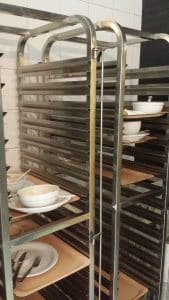
You: Dzień dobry. [Good day]
Worker: Dzień dobry. [Good day]
You: Proszę jeden raz zupa pomidorowa, jeden raz pierogi z mięsem, jeden raz naleśniki z serem, i dwa razy kompot.
Worker: Pierogi ze skwarkami? [Pierogi with cracklings (fried bacon fat)?]
You: Tak, poproszę. [Yes, please]
Worker: Dobra. To wszystko?
You: Tak, dziękuję.
Worker: To bedzie 16,50 (szesnaście złotych i pięćdziesiąt groszy).
You: Ja zapłacę kartą. [I’m paying with my card]
Worker: Dobrze. Już można. [Ok, it’s already possible (to pay with your card)]
Czy Pan(i) potrzebuje potwierdzenie? [Do you need a receipt (for your card)?]
You: Nie dziekuję.
You will then get a receipt (or possibly two if you paid with a credit card and asked for one). Hold onto your receipt and continuing waiting in line. When you approach the counter, hand your receipt to the worker and he or she will bring you your food. If you ordered something that takes longer to make (like pierogi or naleśniki) the worker will return your receipt to you with the items marked off that you have already ordered. Take your food to a table and listen for what you ordered. A worker will shout out when a dish is ready. When you hear your dish (e.g. naleśniki z jabłkiem) being called out, return directly to the counter (don’t wait in line again) and give your receipt to the worker. Once you have received everything, the worker will keep your receipt and you won’t get it back. Enjoy your food and once you’re done, return your dishes to the area marked “Zwrót naczyn.”
Don’t forget to return your dishes!

Bar Rusałka on Floriańska 14 is located just across the Vistula river from Warsaw’s Old Town, right next to the Warsaw zoo and a beautiful cathedral. Prices are average (a bit more expensive than Bar Prasowy) for a milk bar but not particularly cheap – probably due to its great location. The locale itself is less modern that Bar Prasowy but feels homey, even if a bit outdated. In terms of ordering, the process is not really any different than at Bar Prasowy. There is only one menu, however, and it really never changes. In fact all food items remain listed on the board but if they are not serving a certain item at a particular moment that food item will not have a price next to it.
Bar Bambino on Krucza 21 is located within walking distance (about 15 minutes) from the Metro stop “Centrum” and the iconic Palace of Science and Culture, where SRAS programs in Warsaw are hosted. For that reason, it is usually quite full of customers; it is not unusual for the line to be out the door around lunch time. Given the wait, I recommend just trying to take a glance at the menu while you’re in line – it will be on your left. Once again, the ordering process isn’t really any different than any other milk bar except that at Bar Bambino, you will get two receipts – one to give to the server behind the counter and the other for you to keep.
You’ll Also Love
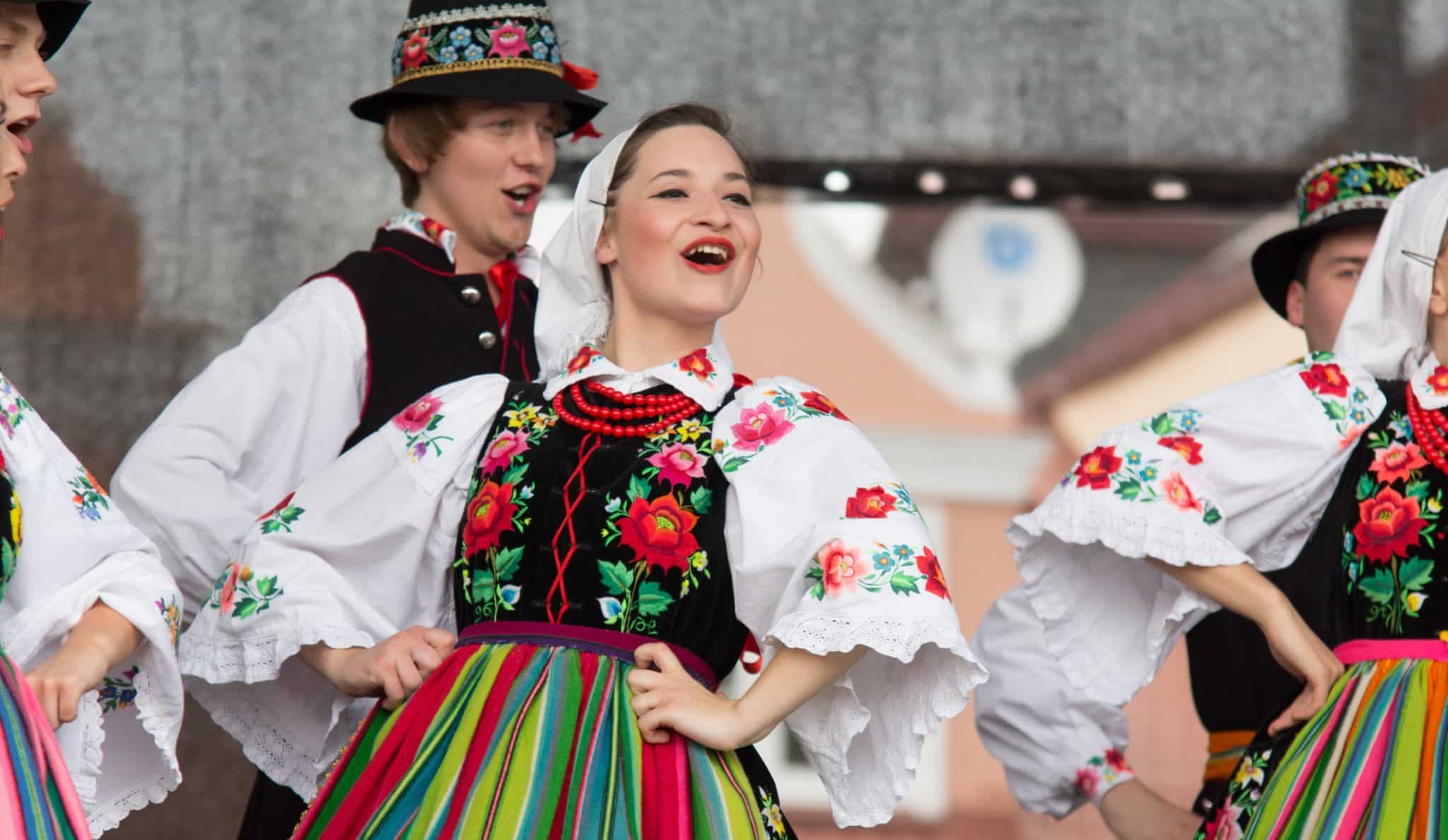
Poland’s Story of Identity: Heroes, Memory, and Meaning
What shapes Polish national identity? The answer is complex and personal, but one key element is the Polish national narrative. This includes the heroes and pivotal events taught in schools, the places central to the nation’s collective memory, and the language and beliefs that frame its worldview. A national narrative goes beyond history: it is […]

Attending Catholic Mass in Poland as an American
Catholic Mass in Poland is not only a religious ritual but also a reflection of the nation’s history, culture, and identity, shaped by centuries in which Catholicism anchored Polish society through partitions, war, and communism. Today, around one-third of Poles attend Mass weekly and 71% identify as Catholic, making Poland one of Europe’s most religious […]

The Talking Polish Phrasebook
The Talking Phrasebook Series presents useful phrases and words in side-by-side translation and with audio files specifically geared to help students work on listening skills and pronunciation. Each entry below, divided by category, features an English word or phrase in the left column and its Polish translation in the right. In the center column for […]
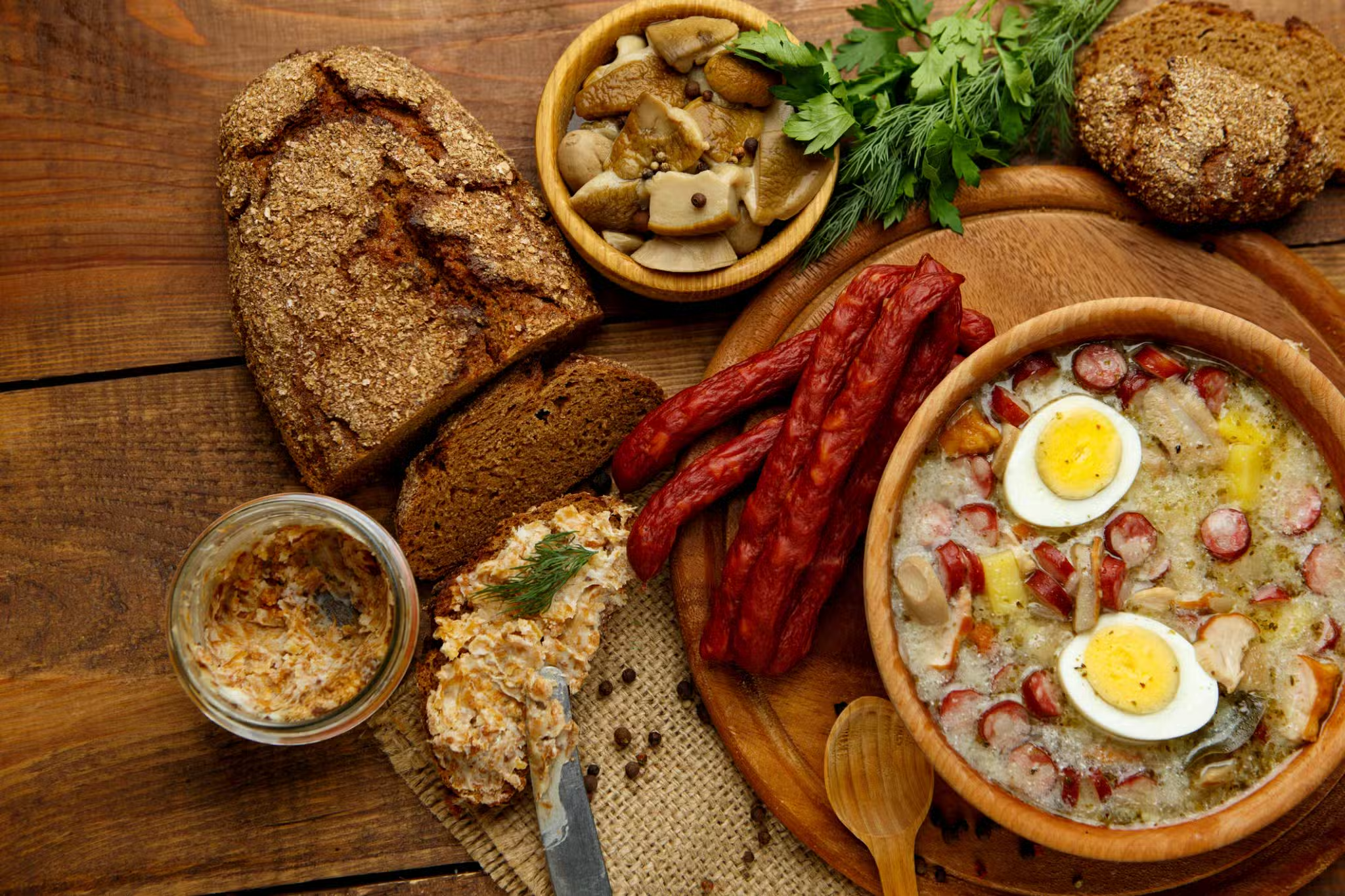
Dictionary of Polish Food
Polish food is hearty, flavorful, and deeply rooted in tradition. It is also experiencing a revival, re-inventing itself in major Polish cities as the country celebrates its heritage and embraces the latest trends and inspirations from world cuisines. Today, while dishes like pierogi, kielbasa, and bigos (hunter’s stew) are one you must try while visiting […]
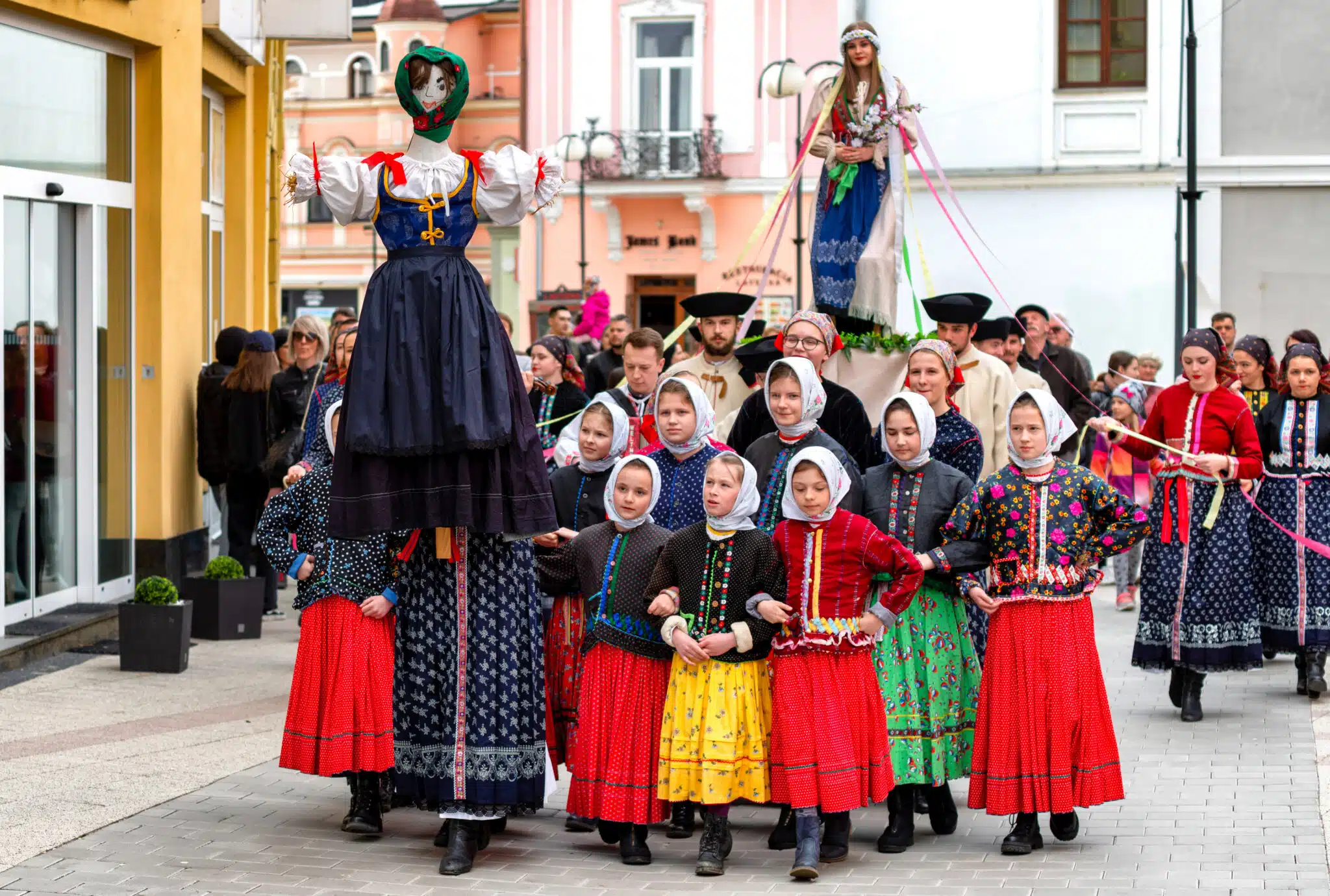
Maslenitsa, Masliana, Meteņi: Spring Holidays of the Slavs and Balts
Rites of welcoming spring and saying goodbye to winter are some of the oldest holidays preserved across Slavic cultures. In the Baltics, the celebrations were nearly lost after being suppressed by Catholic and imperial dominance. Today, Russia’s Maslenitsa is by the far the best-known, but multiple versions exist across the diverse Slavic landscape. In the […]

